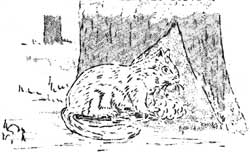NATURAL GRAFT
by Ranger Naturalist George Marler

While squirrels serve a very useful function in aiding reforestation,
yet it is unquestionably rare that their seed scattering and gathering
activities result, in natural tree graft. Along the nature trail at Old
Faithful is found this unique and interesting occurrence.
Under the forked root of a large Lodgepole pine (Pinus contorta),
the seed of a Whitebark pine (Pinus albicaulis) has germinated and
pushed itself out in an angular direction in search of the light. After
merging into the sunlight, another force (geotropic) has changed its
direction of growth in natural alignment with gravity. As the Whitebark
grow from year to year increasing pressure between it and its large
neighbor, with consequent irritations and lessions resulting from trunk
movement brought about by the winds, a complete fusion of the woody
material of both trees took place.
----------
LOST LAKE
by Ranger Naturalist Trusten Peery
"Where is Lost Lake? I've been in the park five times and each time
have tried to find it and failed. Where is it, and why is it on the map
if it isn't there?" Such inquiries at West Thumb are not uncommon, and
it is only natural that a lake indicated on the map as a half mile long
and nearly as wide and located within easy walking distance of the main
loop highway should incite the curiosity of the more adventurous
fishermen. This body of water, according to topographic maps, lies at an
elevation between 8400 and 8500 feet and is less than a mile southwest
of the second crossing of the continental divide on the Old
Faithful-West Thumb road.
But Lost Lake is truly lost, or, perhaps, vanished, and some people
believe that Lost Lake is just a myth. The engineers of the Bureau of
Public Roads in their recent survey of the new Old Faithful-West Thumb
road did not locate it, and neither has it been located by the men
working on insect surveys or forest type mapping crews. Needless to say,
it is difficult to explain to our fishermen friends how the lake came to
be placed on a topographic map, supposedly accurate, and yet cannot be
found even by those who are most familiar with the park.
Some light was thrown on the subject by Dick White, our general
foreman, in a conversation with the author last year. Dick reports that
a road foreman by the name of Billy Ferrell found the lake in the summer
of 1915. Ferrell had lost some horses near Cold Springs, about seven
miles from West Thumb on the way to Snake River. In his search for his
horses, Ferrell traveled northwest and joined the Old Faithful-West
Thumb road about a mile west of the crossing of the Continental divide.
He found the mythical lake about three miles from the latter road, and,
having some fishing tackle with him, tried his luck with splendid
success. A bit more information was obtained this summer from Jack Mears
who worked in Yellowstone Park for many years as a packer. Jack says he
often visited Lost Lake to fish, and that the lake is located only about
three miles southwest of West Thumb. His last visit to the lake was in
1921 and this is the last record, to my knowledge, of anyone having seen
the lake. According to Jack's statement, the lake is misplaced on the
map.
Lost Lake may be existent and perhaps invisible a few feet away as
are many of the smaller lakes in this area and in similar areas where
the timber growth is heavy. If this is true, then one might walk for
days in its vicinity without seeing it. But it is hard to believe that
even a lake of this sort would escape the detailed traverses of the
timber mapping crews. A more logical explanation may be that the lake
has been drained by the cutting back of small tributaries or by
subterranean outlets, aided, perhaps, by the filling in with vegetation.
Such a fate doubtless has befallen many other small glacial lakes in
this area.

